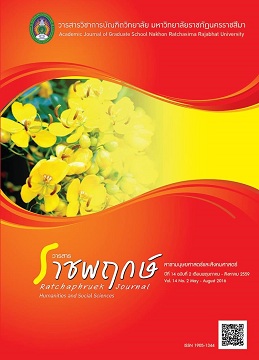กระบวนการเรียนรู้การสวดเบิกของพระภิกษุวัดพระเจดีย์ซาวหลัง พระอารามหลวง อำเภอเมืองลำปาง จังหวัดลำปาง
Main Article Content
Abstract
การวิจัยนี้มีวัตถุประสงค์เพื่อ 1) ศึกษากระบวนการเรียนรู้การสวดเบิกของพระภิกษ วัดพระเจดีย์ซาวหลัง พระ อารามหลวง 2) ศึกษาแนวทางในการนำองค์ความรู้ด้านกระบวนการเรียนรู้การสวดเบิกไปเผยแพร่และฝึกหัดการสวดเบิกแก่ วัดอื่นที่มีความสนใจ โดยการวิจัยเชิงคุณภาพ (Qualitative research) ใช้แบบสัมภาษณ์เชิงลึก (In-depth Interview) แบบมีโครงสร้าง ผู้ให้ข้อมูลประกอบด้วย พระภิกษุ จำนวน 6 รูป ปราชญ์ชุมชน จำนวน 3 คน ผลการวิจัยพบว่า กระบวนการเรียนรู้การสวดเบิกของพระภิกษุวัดพระเจดีย์ซาวหลัง แบ่งได้ 3 ระยะ 3 วิธีการ คือ ระยะที่ 1 พ.ศ. 2461-2497 สมัยพระครูศีลคันธวงศ์ อดีตเจ้าอาวาสวัดพระเจดีย์ซาวหลัง แต่ไม่สามารถค้นพบกระบวนการเรียนรู้การสวดเบิกในช่วงนี้ได้ ระยะที่ 2 พ.ศ. 2498-2533 สมัยพระราชจินดานายก มีกระบวนการเรียนรู้การสวดเบิก คือ สามเณรรวมตัวกัน 6 รูป มีผู้สวดนำแล้วสามเณรฝึกสวดตามทุกวัน ระยะที่ 3 พ.ศ. 2534-ปัจจุบัน สมัยพระครูพิพัฒน์กิจจานุกิจ มีกระบวนการ เรียนรู้การ สวดเบิกในระยะแรก คือ ฝึกสวดตามคณะสวดเบิกทุกคืน เมื่อจำทำนองได้จึงสวดจริงในงานประเพณีสวดเบิก ต่อมาพระภิกษุมีศาสนกิจมากขึ้นจึงไม่สามารถฝึกซ้อมพร้อมกันได้ จึงเปลี่ยนเป็นวิธีฟังเสียงสวดจากแถบเสียงที่บันทึกจากเสียงสวดเบิกจริงแล้วฝึกสวดตาม ปัจจุบันมีการซ้อมก่อนสวดเบิกจริง 1 วัน ทำนองสวดเบิกยังคงเหมือนเดิม ส่วนแนวทางในการนำกระบวนการเรียนรู้การสวดเบิกไปเผยแพร่ คือ เจ้าอาวาสวัดพระเจดีย์ซาวหลัง เปิดโอกาสให้นิสิตวิทยาลัยสงฆ์นครลำปาง และผู้สนใจฝึกสวดเบิก คณะสงฆ์ควรให้ทุกวัดฝึกหัดสวดเบิก การตั้งศูนย์ฝึกสวดเบิกและจัดโครงการทั้งระยะสั้นและระยะยาว จัดภาษาล้านนาและสวดเบิกเป็นวิชาเสริมในมหาวิทยาลัยสงฆ์ส่วนภูมิภาคล้านนา จัดประกวดการสวดเบิก เผยแพร่เอกสารประวัติความเป็นมาของการสวดเบิก เล่าประวัติและความหมายของการสวดเบิกก่อนหรือหลังสวดจบแต่ละวารเพื่อให้ศรัทธาประชาชนทราบลำดับการบำเพ็ญธรรมปฏิบัติของพระพุทธเจ้า
Learning Process of Chanting for Auspiciousness of Monks at Phrajedi Chaolang Royal Monastery, Lampang Province
The objectives of this research were aimed to study 1) the learning process of chanting for auspiciousness of monks at Phrajedi Chaolang Royal Monastery and 2) to study guidelines for disseminating knowledge about the learning procedures of chanting for auspiciousness and practices to other temples. This is a qualitative research and uses structured in-depth interviews. The respondents include 6 monks and 3 community philosophers.
Results:
Learning process of chanting for auspiciousness of monks at Phrajedi Chaolang Royal Monastery can be separated into 3 different phases with methods. The 1st phrase B.E.1918-1954 in the era of Phrakru Silkantawong, the former abbot of Phrajedi Chaolang Royal Monastery, the procedures of chanting for auspiciousness were not discovered for this phase. The 2nd phase B.E.1955-1990, in the era of Phraratjindanayok, the chanting for auspiciousness was 6 novices, an ordained novice led chanting and others followed and practiced everyday. The 3rd phase B.E.1991 to the present in the era of Phrakru Pipatkitjanukij; the chanting for auspiciousness at first was practiced every night as a group. When the chant was memorized, it was used for the chanting for auspiciousness ceremony. However, as the monks had more religious business, they could not practice together and method was changed. Currently, the monks practice 1 day before the actual chanting. The abbot of Phrajedi Chaolang Royal Monastery now provides the opportunity for students from Lampang Buddhist College and others who are interested to practice. It is an extracurricular subject in Lanna Regional Buddhist College, ordination chanting for auspiciousness contests are organized, and historic information including the meanings for the different stages are disseminated so that students are able to learn the orders of dharma practices of the Buddha.


